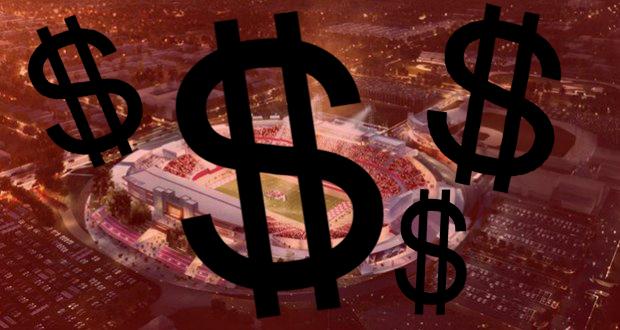The modernization of Bulldog Stadium is still happening — but it might take a while.
The Fresno Bee reported on Jan. 14 that Fresno State had “shelved” its $60 million Bulldog Stadium modernization project plans and was instead focused on upgrading the Robert E. Duncan Athletic Building and the Student-Athlete village.
Fundraising for the Bulldog Stadium modernization project was on the right track, according to former Athletic Director Jim Bartko, who said last semester that the department had donation commitments of more than $10 million. He had announced his plans for stadium renovations in the summer of 2015 after a $1.5 million donation from a former student-athlete who wished to remain anonymous.
Shortly after, the design and development phase began.
Engineering firm AECOM was to discuss modernization plans with the athletic department, Bartko had said, and the university was to determine what price it could afford and move forward from there. The expected cost of renovations was around $60 million to $70 million, according to Bartko.
In a statement to The Collegian, Steve Robertello, interim athletic director, said that it was “recent information regarding financing viability of the project” that has led the university to adjust its plans.
“The original feasibility study [and] concept plan anticipated that the project would be implemented in multiple phases over several years under a ‘best case’ scenario,” Robertello said. “While work is already underway, we acknowledge that the original timeline for the total vision may have been optimistic.”
Robertello stated that any donor who pledged funds toward the modernization project can revisit that pledge. In the coming months, Robertello assured, the university will roll out new plans for the Bulldog Stadium project, which are expected to be completed for approval by the California State University trustees in early 2019.
Though it’s not a shiny new stadium as some may have once wished for, Robertello said, the renovations sought by the university in the near future will still “dramatically improve the gameday experience for Red Wave fans.”
Bartko, who resigned from his position last semester citing personal reasons, wanted just that, according to a statement he gave in 2015. He also hoped that the Bulldog Stadium renovations would attract crowds to fill the Stadium.
This season, the Fresno State football team drew 30,362 people in average attendance in the football team’s 9-3 season. The team lost in the Mountain West Championship and won the Hawaii Bowl.
That came after the worst season in Fresno State history. The team finished 1-11 in 2016 and averaged an attendance of 25,493. Former head coach Tim DeRuyter was fired midseason.
In 2013, the attendance average was 36,917, and in 2008 it was 37,864.
Robertello has also looked into a potential expansion and upgrade of facilities in the Student Athlete Village to improve teams’ overall success.
“This approach will serve all 21 of our sports teams and is fully endorsed by Coach [Jeff] Tedford and our other head coaches,” Robertello said. “We collectively believe improvements of this kind will lead to enhanced recruitment success and, ultimately, the success of our student-athletes and sports programs.”
In addition to attempt to improve teams’ success, Robertello stated that the university would carry out small renovations around Bulldog Stadium in the near future.
According to Robertello, the athletics department and the university are focusing on the most cost-effective upgrades for now. He said that the university has decided to focus on facility upgrades before addressing modernization plans once heavily sought for Bulldog Stadium, like premium seating.
But among plans that might soon be a reality is making the stadium more accessible in terms of complying with the Americans with Disabilities Act rules on seating, parking, restrooms and elevators, Robertello said. There is also a focus on upgrading concession areas and restrooms as well as replacing aging utility and technological infrastructure.
The stadium has run into emergency repair cases in the past, like when an irrigation pipe burst last semester under the southeast side of the stadium.
And though work is being done on the smaller areas of the stadium, Robertello said that the modernization project “continues to be an urgent priority and has not been placed on hold.”




